|
DIRE STRAITS
The Greater Bamboo Lemur (Hapalemur simus), is arguably the most critically
endangered lemur species. It is the primate panda of Madagascar.
From the subfossil record, we know that 17
species of giant lemur have gone extinct in Madagascar, with some
persisting until as recently as around 500 years ago.
Greater Bamboo Lemurs were once widespread throughout the west and north of
Madagascar. The only eyewitness accounts of living H. simus come from the
eastern rainforest. Before the 1970s, greater bamboo lemur individuals
were known from two sites, and then in the last twenty years another three
groups have been discovered in
Ranomafana National Park.
Years of following the groups in Ranomafana have shown that the diet of
this species consists of 95% bamboo - primarily one species of large
endemic bamboo. Estimates of total population numbers suggest that today
there are less than 100 individuals surviving in the wild. In 2007 a
survey has found a large group of 17 individuals in a fragment of forest
called Mahasoa (see satellite image slide show).
We are proposing purchase of this
forest fragment of 10ha plus an adjacent fragment and the corridor of
habitat between the two so that we can enable this population of greater
bamboo lemurs to expand and grow. Recently in collaboration with a
Malagasy NGO, MICET,
we have begun purchasing land as a last ditch effort
to save the surviving members of this species.
GREATER BAMBOO LEMUR FACTS
The greater bamboo lemur lives in social groups of 6-26 with multiple
females giving birth to one infant a year in the months of November and
December. The breeding season is June and July and offspring leave their
natal group at between three to five years of age. 95% of the greater
bamboo lemur diet is the stalks, leaves and shoots of the giant bamboo
endemic to Madagascar, Cathyostachyum viguiri. Life expectancy of the
greater bamboo lemur is unknown but could be, like other lemurs, as long
as 30 years. Body weight is comparable with that of a domestic cat,
almost 3 kilograms or 7 pounds. The fur color is charcoal grey with bright
white ear tufts, there is a golden ring at the base of the tail and a dark
face. The closest living relative of the greater bamboo lemur is the
Golden Bamboo Lemur (Hapalemur aureus),
also critically endangered. However, unlike the relic
populations of Greater Bamboo Lemurs, surveys have found over 2000 Golden
Bamboo Lemurs in the wild. In the second land purchase site both of these
endangered species occur in the same forest. There are less than 50 H.
simus in zoos in Europe and Madagascar and reproduction in captivity has
not been very successful.
BELLWETHER FOR GLOBAL CLIMATE CHANGE
Bamboo is fast growing and relies directly on rain to grow and reproduce.
As Madagascar's climate has been drying out due to fires, habitat
destruction, soil erosion, and climate change, bamboo disappears and with
it the animals that rely on it for food. At this point we have two
options, the greater bamboo lemur can become another casualty of
un-checked climate change, or we can reverse this trend by forest
preservation and restoration which will serve to hold moisture in the
habitat thus allowing the bamboo and bamboo lemurs to survive.
HOPE FOR THE FUTURE
It is not too late for the Greater Bamboo Lemur. Bamboo is fast-growing,
so the habitat for these lemurs can be restored within a few years, if
fire can be prevented. Hunting is a second cause of lemur demise. It can
be stopped with education regarding sustainable practices and monitoring
of protected areas. Therefore, we propose a program of
-
land purchase at Mahasoa and Ambatolahy Dimy
-
hiring and training local residents as rangers to protect the land from
fire and poaching,
-
a powerful local public awareness campaign
-
restoration of forest/bamboo in the corridor between fragments.
With the knowledge we have of Mahasoa land purchase costs, we estimate
the cost of these two forest fragments and the kilometer strip between
them is $160,000. A second parcel of land outside Ranomafana National Park
may also be purchased for an additional $20,000 with hope of doubling the
population there. With the knowledge we have on population growth of this
species, we predict that we can more than double the known population of
Greater Bamboo Lemurs within five years. With this concerted effort to
purchase, protect and restore habitat, it is possible to save this species
which is greatly at risk of joining the other subfossil lemurs in
extinction.
ICTE/MICET credentials
Institute for the Conservation of Tropical Environments
is a university-based NGO which has worked in Madagascar for 21 years.
ICTE's Director, Pat Wright,
has received two medals of honor from the government of
Madagascar for her effective conservation work. Using science based
conservation, we have emphasized Malagasy capacity building, training and
research, collaborating closely with Malagasy colleagues. Our first
project was to develop the Ranomafana National Park, now one of the most
successful parks in Madagascar. Centre ValBio, the hub of operations in
Ranomafana National Park, is a research station inaugurated in 2003.
HOW TO DONATE
Discover Life and ICTE/MICET are working together to raise $500,000
for our "Campaign to save the critically endangered Greater Bamboo Lemur".
Please click here for instructions on how to make a gift.
|
|
Click on images to enlarge them.
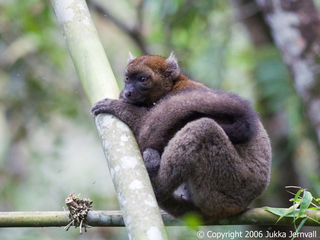
Photograph by Jukka Jernvall
Hapalemur simus Gray, 1870
Male Greater Bamboo Lemur
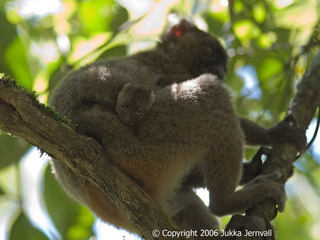
Photograph by Jukka Jernvall
Hapalemur simus Gray, 1870
Mother and infant Greater Bamboo Lemurs
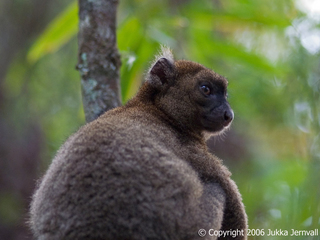
Photograph by Jukka Jernvall
Hapalemur simus Gray, 1870
Male Greater Bamboo Lemur
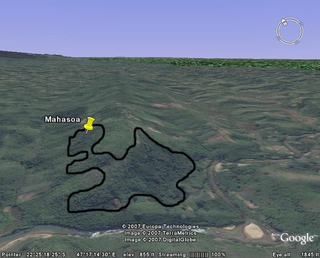
Photograph by GoogleEarth
Mahasoa and surrounding conservation area
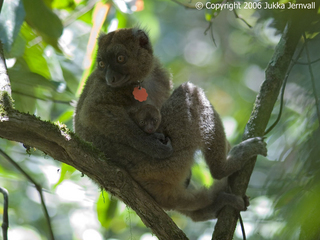
Photograph by Jukka Jernvall
Hapalemur simus Gray, 1870
Tagged mother and infant
Greater Bamboo Lemurs
|